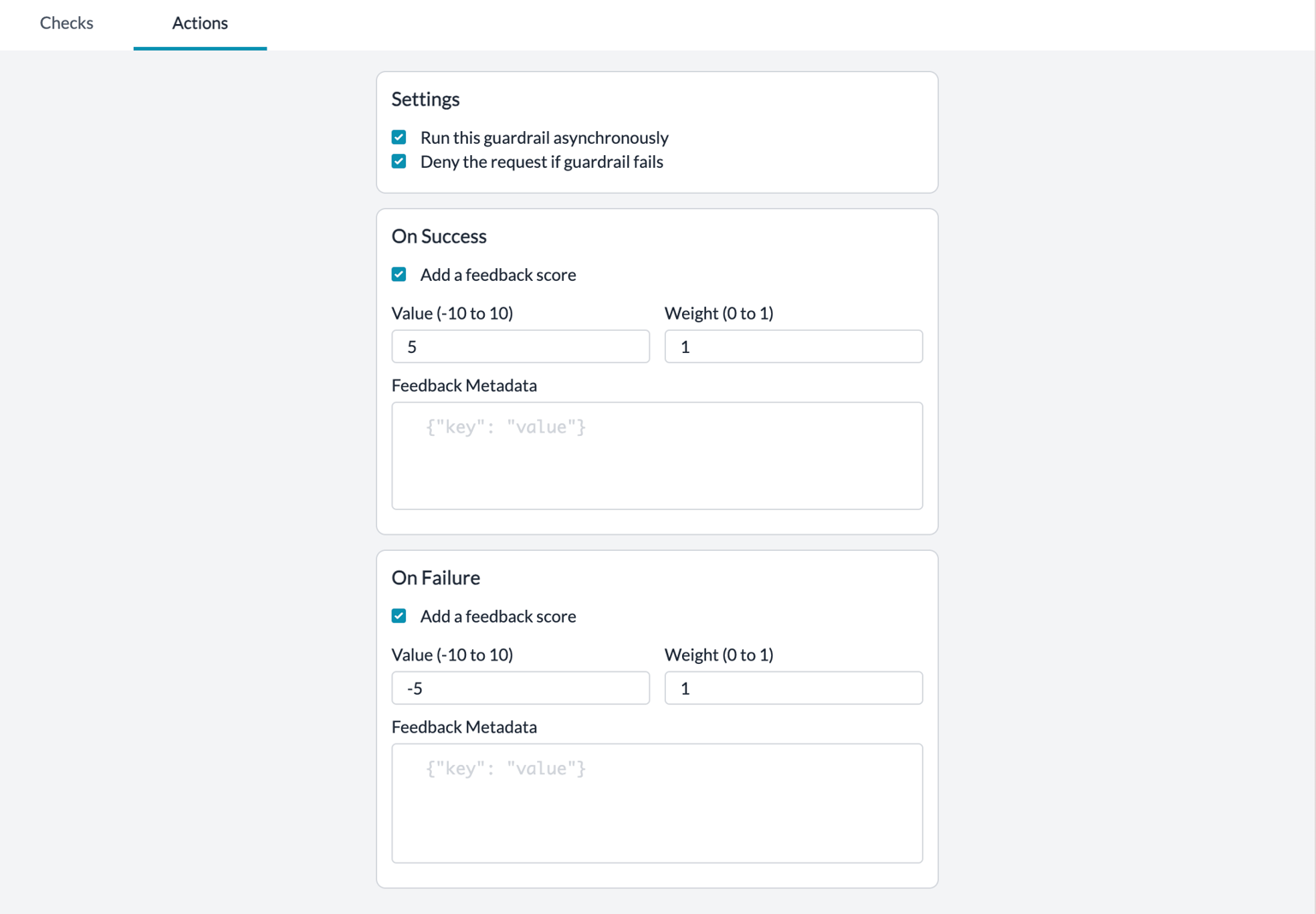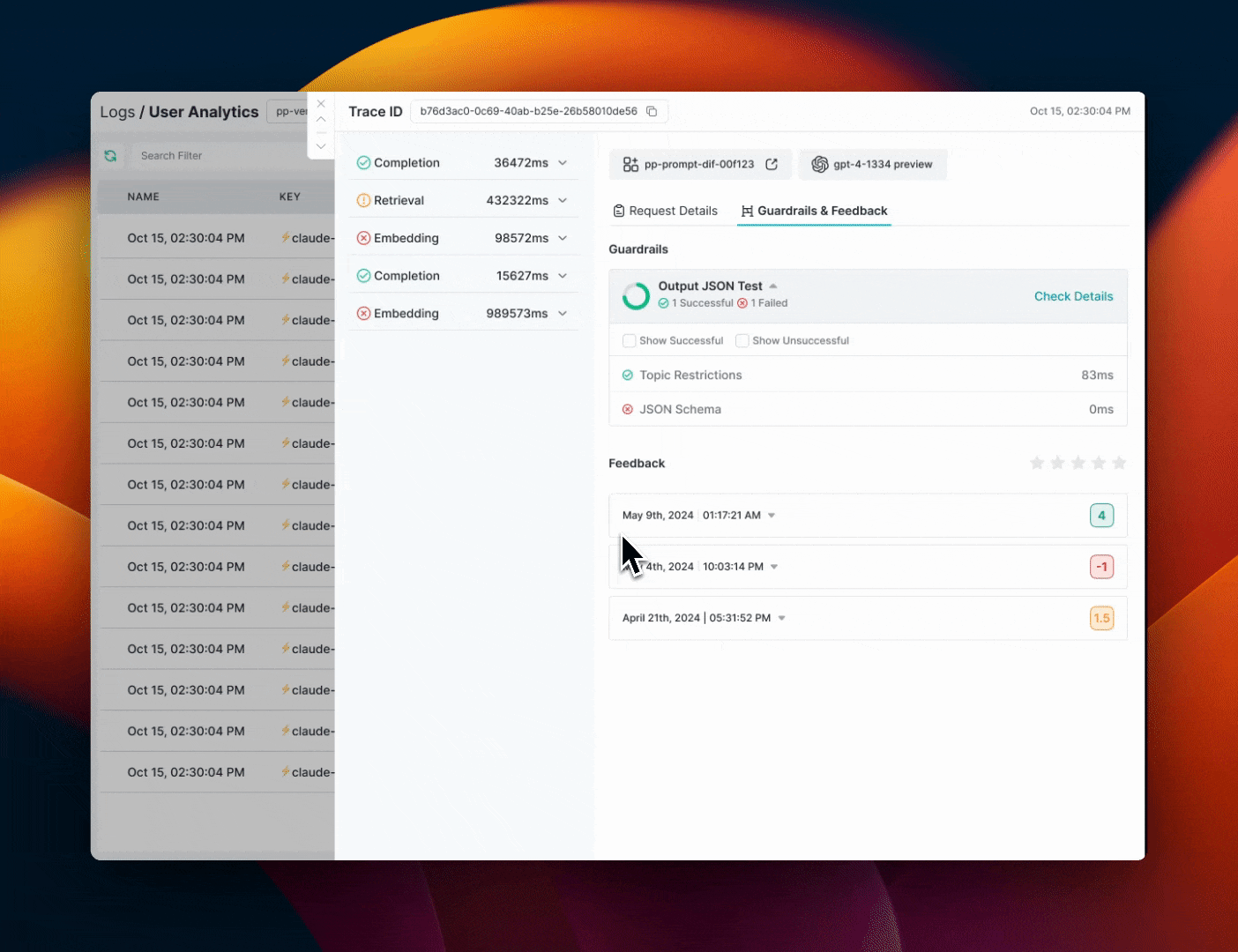This feature is available on all plans.
- Developer: Access to
BASICGuardrails - Production: Access to
BASIC,PARTNER,PROGuardrails. - Enterprise: Access to all Guardrails plus
customGuardrails.
400/500 errors, but also in their core behavior. You can get a response with a 200 status code that completely errors out for your app’s pipeline due to mismatched output. With Portkey’s Guardrails, we now help you enforce LLM behavior in real-time with our Guardrails on the Gateway pattern.
Use Portkey’s Guardrails to verify your LLM inputs AND outputs, adhering to your specifed checks. Since Guardrails are built on top of our Gateway, you can orchestrate your request - with actions ranging from denying the request, logging the guardrail result, creating an evals dataset, falling back to another LLM or prompt, retrying the request, and more.
Examples of Guardrails Portkey offers:
- Regex match - Check if the request or response text matches a regex pattern
- JSON Schema - Check if the response JSON matches a JSON schema
- Contains Code - Checks if the content contains code of format SQL, Python, TypeScript, etc.
- Custom guardrail - If you are running a custom guardrail currently, you can also integrate it with Portkey
- …and many more.
Detect Gibberish, Scan for prompt injection, and more. These guardrails serve as protective barriers that help mitigate risks associated with Gen AI, ensuring its responsible and ethical deployment within organizations.
List of supported Guardrail checks here
Portkey also integrates with your favourite Guardrail platforms like Aporia, SydeLabs, Pillar Security and more. Just add their API keys to Portkey and you can enable their guardrails policies on your Portkey calls! More details on Guardrail Partners here.
Using Guardrails
Putting Portkey Guardrails in production is just a 4-step process:- Create Guardrail Checks
- Create Guardrail Actions
- Enable Guardrail through Configs
- Attach the Config to a Request

Portkey only evaluates the last message in the request body when running guardrails checks.
1. Create a New Guardrail & Add Checks
On theGuardrails page, click on Create and add your preferred Guardrail checks from the right sidebar.
On Portkey, you can configure Guardrails to be run on either the
INPUT (i.e. PROMPT) or the OUTPUT. Hence, for the Guardrail you create, make sure your Guardrail is only validating ONLY ONE OF the Input or the Output.
- You can add as many checks as you want to a single Guardrail.
- A check ONLY returns a boolean (
Yes/No) verdict.
List of Guardrail checks
2. Add Guardrail Actions
Define a basic orchestration logic for your Guardrail here.Guardrail is created to validate ONLY ONE OF the
Input or the Output. The Actions set here will also apply only to either the request or the response.
There are 6 Types of Guardrail Actions
| Action | State | Description | Impact |
|---|---|---|---|
| Async | TRUE This is the default state | Run the Guardrail checks asynchronously along with the LLM request. | Will add no latency to your requestUseful when you only want to log guardrail checks without affecting the request |
| Async | FALSE | On Request Run the Guardrail check BEFORE sending the request to the LLM On Response Run the Guardrail check BEFORE sending the response to the user | Will add latency to the requestUseful when your Guardrail critical and you want more orchestration over your request based on the Guardrail result |
| Deny | TRUE | On Request & Response If any of the Guardrail checks FAIL, the request will be killed with a 446 status code. If all of the Guardrail checks SUCCEED, the request/response will be sent further with a 200 status code. | This is useful when your Guardrails are critical and upon them failing, you can not run the requestWe would advice running this action on a subset of your requests to first see the impact |
| Deny | FALSE This is the default state | On Request & Response If any of the Guardrail checks FAIL, the request will STILL be sent, but with a 246 status code. If all of the Guardrail checks SUCCEED, the request/response will be sent further with a 200 status code. | This is useful when you want to log the Guardrail result but do not want it to affect your result |
| On Success | Send Feedback | If all of the Guardrail checks PASS, append your custom defined feedback to the request | We recommend setting up this actionThis will help you build an “Evals dataset” of Guardrail results on your requests over time |
| On Failure | Send Feedback | If any of the Guardrail checks FAIL, append your custom feedback to the request | We recommend setting up this actionThis will help you build an “Evals dataset” of Guardrail results on your requests over time |
$Guardrail_ID that you can then add to your request.
3. “Enable” the Guardrails through Configs
This is where Portkey’s magic comes into play. The Guardrail you created above is yet not anActive guardrail because it is not attached to any request.
Configs is one of Portkey’s most powerful features and is used to define all kinds of request orchestration - everything from caching, retries, fallbacks, timeouts, to load balancing.
Now, you can use Configs to add Guardrail checks & actions to your request.
Option 1: Direct Guardrail Configuration (Recommended)
Portkey now offers a more intuitive way to add guardrails to your configurations:| Config Key | Value | Description |
|---|---|---|
| input_guardrails | ["guardrails-id-xxx", "guardrails-id-yyy"] | Apply these guardrails to the INPUT before sending to LLM |
| output_guardrails | ["guardrails-id-xxx", "guardrails-id-yyy"] | Apply these guardrails to the OUTPUT from the LLM |
Option 2: Hook-Based Configuration (For Creating Raw Guardrails)
You can also continue to use the original hook-based approach:| Type | Config Key | Value | Description |
|---|---|---|---|
| Before Request Hook | before_request_hooks | [{"id":"$guardrail_id"}] | These hooks run on the INPUT before sending to the LLM |
| After Request Hook | after_request_hooks | [{"id":"$guardrail_id"}] | These hooks run on the OUTPUT after receiving from the LLM |
Both configuration approaches work identically - choose whichever is more intuitive for your team. The simplified
input_guardrails and output_guardrails fields are recommended for better readability.Guardrail Behaviour on the Gateway
For asynchronous guardrails (async= TRUE), Portkey returns the standard, default status codes from the LLM providers — this is because the Guardrails verdict is not affecting how you orchestrate your requests. Portkey will only log the Guardrail result for you.
But for synchronous requests (async= FALSE), Portkey can orchestrate your requests based on the Guardrail verdict. The behaviour is dependent on the following:
- Guardrail Check Verdict (
PASSorFAIL) AND - Guardrail Action — DENY Setting (
TRUEorFALSE)
request status codes corresponding to your set Guardrail behaviour.
For requests where async= FALSE:
| Guardrail Verdict | DENY Setting | Returned Status Code | Description |
|---|---|---|---|
| PASS | FALSE | 200 | Guardrails have passed, request will be processed regardless |
| PASS | TRUE | 200 | Guardrails have passed, request will be processed regardless |
| FAIL | FALSE | 246 | Guardrails have failed, but the request should still **be processed.**Portkey introduces a new Status code to indicate this state. |
| FAIL | TRUE | 446 | Guardrails have failed, and the request should not **be processed.**Portkey introduces a new Status code to indicate this state. |
Example Config Using the New 246 & 446 Status Codes
- Fallback to Another Model on Guardrail Fail
- Retry on Guardrail Fail (Simplified)
4. Final Step - Attach Config to Request
Now, while instantiating your Portkey client or while sending headers, just pass the Config ID.Viewing Guardrail Results in Portkey Logs
Portkey Logs will show you detailed information about Guardrail results for each request.On the Feedback & Guardrails tab on the log drawer, you can see
Guardrail Details
- Overview: How many checks
passedand how manyfailed - Verdict: Guardrail verdict for each of the checks in your Guardrail
- Latency: Round trip time for each check in your Guardrail
Feedback Details
Portkey will also show the feedback object logged for each requestValue:** The numerical feedback value you passedWeight: The numerical feedback weightMetadata Key & Value:** Any custom metadata sent with the feedbacksuccessfulChecks: Which checks associated with this requestpassedfailedChecks: Which checks associated with this requestfailederroredChecks: If there were any checks that errored out along the way

Understanding Guardrail Response Structure
When Guardrails are enabled and configured to run synchronously (async=false), Portkey adds a hook_results object to your API responses. This object provides detailed information about the guardrail checks that were performed and their outcomes.
Hook Results Structure
Thehook_results object contains two main sections:
Example Hook Results
Non-Streaming Responses
Here’s a simplified example of what thehook_results might look like in a non-streaming response:
config like:
Streaming Responses
Portkey now supports hook results in streaming responses for
/chat/completions, /completions, /embeddings, and /messages endpoints. This allows you to stop streaming or show redacted content if a request violates your guardrail policies, enabling clients to respect content policy guidelines in real-time.x-portkey-strict-open-ai-compliance header to false.
For the
/messages endpoint (Anthropic), it is not possible to access hook results through the Anthropic SDK because the SDK only parses Anthropic-specific events. Use cURL or raw HTTP requests to access hook results for this endpoint.stream=True), the hook results are available in the .model_extra.hook_results parameter of the response chunks. This applies to:
.chat.completions.create()withstream=True.completions.create()withstream=True.embeddings.create()withstream=True
Important Notes
- If a guardrail is configured to run asynchronously (
async=true), thehook_resultswill not appear in the API response. The results will only be available in the Portkey logs. - The
datafield varies based on the type of guardrail check being performed. Each guardrail type returns different information relevant to its function. - The overall
verdictfor a guardrail istrueonly if all individual checks pass. If any check fails, the verdict will befalse. - When
transformedistrue, it indicates that the guardrail has modified the content (such as redacting PII). - If
denyistrueand the verdict isfalse, the request will be denied with a 446 status code.
Special Fields
- Check-specific data: Each guardrail type provides different data in the
datafield. For example, a sentence count check provides information about the number of sentences, while a PII check might provide information about detected PII entities. - Feedback metadata: The
metadataobject withinfeedbackkeeps track of which checks were successful, failed, or encountered errors.
Defining Guardrails Directly in JSON
On Portkey, you can also create the Guardrails in code and add them to your Configs. Read more about this here:Creating Raw Guardrails (in JSON
Bring Your Own Guardrails
If you already have a custom guardrail pipeline where you send your inputs/outputs for evaluation, you can integrate it with Portkey using a modular, custom webhook! Read more here:Bring Your Own Guardrails
Examples of When to Deny Requests with Guardrails
- Prompt Injection Checks: Preventing inputs that could alter the behavior of the AI model or manipulate its responses.
- Moderation Checks: Ensuring responses do not contain offensive, harmful, or inappropriate content.
- Compliance Checks: Verifying that inputs and outputs comply with regulatory requirements or organizational policies.
- Security Checks: Blocking requests that contain potentially harmful content, such as SQL injection attempts or cross-site scripting (XSS) payloads.

